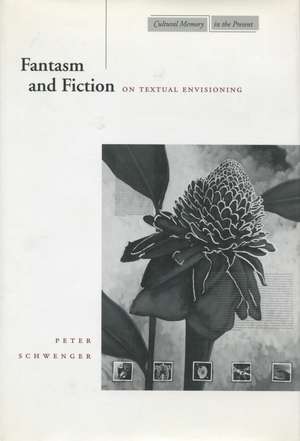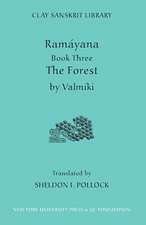Fantasm and Fiction: On Textual Envisioning: Cultural Memory in the Present
Autor Peter Schwengeren Limba Engleză Hardback – 31 mai 1999
Mental image, dream, fantasy, hallucination—all these are comprised in the psychoanalytic concept of the fantasm. Perhaps only such a multifarious concept is adequate to the range of visual elements involved in the experience of reading fiction, or of writing it. Soon after the birth of the novel, doctors expressed concern that readers might be possessed by what they were reading, haunted by textual fantasms. Contemporary writers like John Gardner, Maurice Blanchot, and John Banville figure this possession as a kind of textual dreaming: fiction, like dream, draws from a fantasmal unconscious.
For the reader's images to become conscious, however, they must be cued by a material text through framing strategies and evocative gaps. This book analyzes the complex relationship between the fantasmal experience and the material text, reading a wide range of works—such as Calvino's If on a Winter's Night a Traveller, Coleridge's "Kubla Khan," Sorrentino's Mulligan Stew, and Rimbaud's "The Vowels"—that treat explicitly what is implicit in reading.
Although the specific images of individual readers cannot be predicted, one can speculate on the modes of these images: are they focused or fogged, schematic or emotive, fleeting or enduring? These are questions not only for theorists but for artists who make textual visualization visible. Drawing on artists' books, marginal drawings by authors, and films such as Prospero's Books, Fantasm and Fiction illuminates the process of textual visualization.
The author develops, in addition, "A Politics of Visualization" through analyses of the photographs of David Wojnarowicz, Derek Jarman's film Blue, and Nicole Brossard's novel Picture Theory. In this richly suggestive study, the fantasm emerges as a crucial aspect not only of reading but of any kind of envisioning.
For the reader's images to become conscious, however, they must be cued by a material text through framing strategies and evocative gaps. This book analyzes the complex relationship between the fantasmal experience and the material text, reading a wide range of works—such as Calvino's If on a Winter's Night a Traveller, Coleridge's "Kubla Khan," Sorrentino's Mulligan Stew, and Rimbaud's "The Vowels"—that treat explicitly what is implicit in reading.
Although the specific images of individual readers cannot be predicted, one can speculate on the modes of these images: are they focused or fogged, schematic or emotive, fleeting or enduring? These are questions not only for theorists but for artists who make textual visualization visible. Drawing on artists' books, marginal drawings by authors, and films such as Prospero's Books, Fantasm and Fiction illuminates the process of textual visualization.
The author develops, in addition, "A Politics of Visualization" through analyses of the photographs of David Wojnarowicz, Derek Jarman's film Blue, and Nicole Brossard's novel Picture Theory. In this richly suggestive study, the fantasm emerges as a crucial aspect not only of reading but of any kind of envisioning.
| Toate formatele și edițiile | Preț | Express |
|---|---|---|
| Paperback (1) | 201.90 lei 3-5 săpt. | |
| Stanford University Press – 31 mai 1999 | 201.90 lei 3-5 săpt. | |
| Hardback (1) | 720.11 lei 6-8 săpt. | |
| Stanford University Press – 31 mai 1999 | 720.11 lei 6-8 săpt. |
Din seria Cultural Memory in the Present
-
 Preț: 173.10 lei
Preț: 173.10 lei -
 Preț: 197.12 lei
Preț: 197.12 lei -
 Preț: 365.56 lei
Preț: 365.56 lei -
 Preț: 193.14 lei
Preț: 193.14 lei -
 Preț: 194.26 lei
Preț: 194.26 lei -
 Preț: 155.84 lei
Preț: 155.84 lei -
 Preț: 155.89 lei
Preț: 155.89 lei -
 Preț: 149.68 lei
Preț: 149.68 lei -
 Preț: 211.98 lei
Preț: 211.98 lei -
 Preț: 228.62 lei
Preț: 228.62 lei -
 Preț: 206.94 lei
Preț: 206.94 lei -
 Preț: 209.36 lei
Preț: 209.36 lei -
 Preț: 193.58 lei
Preț: 193.58 lei -
 Preț: 156.25 lei
Preț: 156.25 lei -
 Preț: 146.22 lei
Preț: 146.22 lei -
 Preț: 171.47 lei
Preț: 171.47 lei -
 Preț: 194.45 lei
Preț: 194.45 lei -
 Preț: 229.26 lei
Preț: 229.26 lei -
 Preț: 296.64 lei
Preț: 296.64 lei -
 Preț: 210.24 lei
Preț: 210.24 lei -
 Preț: 228.62 lei
Preț: 228.62 lei -
 Preț: 278.31 lei
Preț: 278.31 lei -
 Preț: 298.62 lei
Preț: 298.62 lei -
 Preț: 153.16 lei
Preț: 153.16 lei -
 Preț: 193.58 lei
Preț: 193.58 lei -
 Preț: 204.76 lei
Preț: 204.76 lei -
 Preț: 228.39 lei
Preț: 228.39 lei -
 Preț: 139.64 lei
Preț: 139.64 lei -
 Preț: 243.46 lei
Preț: 243.46 lei -
 Preț: 201.90 lei
Preț: 201.90 lei -
 Preț: 152.36 lei
Preț: 152.36 lei -
 Preț: 226.40 lei
Preț: 226.40 lei -
 Preț: 169.59 lei
Preț: 169.59 lei -
 Preț: 197.12 lei
Preț: 197.12 lei -
 Preț: 194.88 lei
Preț: 194.88 lei -
 Preț: 170.65 lei
Preț: 170.65 lei -
 Preț: 194.45 lei
Preț: 194.45 lei -
 Preț: 151.12 lei
Preț: 151.12 lei -
 Preț: 194.01 lei
Preț: 194.01 lei -
 Preț: 194.45 lei
Preț: 194.45 lei -
 Preț: 208.06 lei
Preț: 208.06 lei -
 Preț: 196.69 lei
Preț: 196.69 lei -
 Preț: 142.73 lei
Preț: 142.73 lei -
 Preț: 466.14 lei
Preț: 466.14 lei -
 Preț: 167.15 lei
Preț: 167.15 lei -
 Preț: 194.45 lei
Preț: 194.45 lei -
 Preț: 173.51 lei
Preț: 173.51 lei -
 Preț: 232.11 lei
Preț: 232.11 lei -
 Preț: 207.13 lei
Preț: 207.13 lei -
 Preț: 150.09 lei
Preț: 150.09 lei
Preț: 720.11 lei
Preț vechi: 935.20 lei
-23% Nou
Puncte Express: 1080
Preț estimativ în valută:
137.81€ • 143.34$ • 113.77£
137.81€ • 143.34$ • 113.77£
Carte tipărită la comandă
Livrare economică 12-26 aprilie
Preluare comenzi: 021 569.72.76
Specificații
ISBN-13: 9780804733434
ISBN-10: 0804733430
Pagini: 192
Dimensiuni: 127 x 203 x 20 mm
Greutate: 0.44 kg
Ediția:1
Editura: Stanford University Press
Colecția Stanford University Press
Seria Cultural Memory in the Present
ISBN-10: 0804733430
Pagini: 192
Dimensiuni: 127 x 203 x 20 mm
Greutate: 0.44 kg
Ediția:1
Editura: Stanford University Press
Colecția Stanford University Press
Seria Cultural Memory in the Present
Recenzii
"This is one of a handful of books of criticism that has and wil continue to profoundly affect how I think about reading. Fantasm and Fiction makes a timely contribution to a trend in literarty criticism just coming into its own, takes a deserved place in the challenging and presitigious Cultural Memory in the Present series form Stanford, and provides stimulating and exemplary critical thought for all readers of literature."—Henry Street
Notă biografică
Peter Schwenger is Professor of English at Mount St. Vincent University, Halifax, Nova Scotia.
Textul de pe ultima copertă
“This is one of a handful of books of criticism that has and wil continue to profoundly affect how I think about reading. Fantasm and Fiction makes a timely contribution to a trend in literarty criticism just coming into its own, takes a deserved place in the challenging and presitigious Cultural Memory in the Present series form Stanford, and provides stimulating and exemplary critical thought for all readers of literature.”—Henry Street
Descriere
This book analyzes the complex relationship between the fantasmal experience and the material text, reading a wide range of works that treat explicitly what is implicit in reading. Also, drawing on artists' books, drawings by authors, and films such as Prospero's Books, the author illuminates the process of textual visualization.













